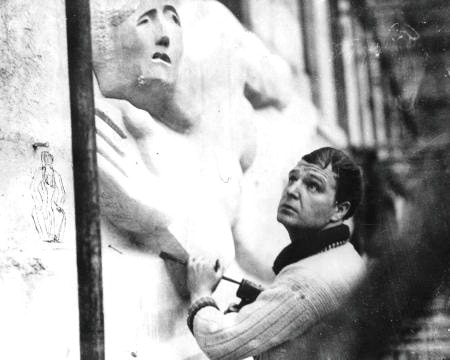|
55 Broadway was officially opened on 1st December 1929. Designed by Charles Holden as the new headquarters for the London Transport Board, it replaced the previous hodge podge of buildings the board used in the same area. The new building brought together different departments under one roof, allowing faster communication and creating a corporate atmosphere. As well uniting the company under one roof, the building would also contain St James Park tube station. Holden, and his firm, Adams, Holden & Pearson, were appointed to the design in 1925, after an initial plan by Sir A.E. Richardson was rejected by LTB director Frank Pick for being too old fashioned. The site chosen for the building was an awkward, asymmetrical plot, hemmed in by other buildings. To counteract these problems, Holden arranged the building in an irregular cruciform plan, with a long east-west axis and a shorter north-south one. The upper floors step up, getting smaller in floor area as it gets to the top. This allows natural light into each office, as well as allowing more light down to street level. The services such as lifts and ventilation were built into the central tower core. Holden had previously specialized in the design of hospitals when he joined the firm of Henry Percy Adams (later to become Adams, Holden & Pearson) at the start of the 1900’s. This experience was to provide useful in creating the large, integrated design of 55 Broadway. Another influence on the design was that of the fifteen-storey General Motors Building in Detroit (1919-22) by Albert Khan, also designed to allow sunlight and air to each of the buildings numerous offices. 55 Broadway is constructed around a steel frame encased in concrete and then clad in stone. Portland Stone, a material Holden had used on a smaller scale for London Transport in his Northern Line Extension stations a few years earlier, was used from the 3rd floor upwards, with blue-green Norwegian granite for the first and second floor. Inside, flooring of Travertine limestone forms three paved public arcades and covers the staircases, with bronze used for the railings. Each floor contains a drinking fountain and an automatic mail chute, details picked up from American office designs of the time. The exterior of the building was decorated with a range of sculptures, produced by a number of different artists. Reliefs depicting “The Four Winds” were sculpted by Eric Gill, Henry Moore, Alfred Gerrard, Eric Aumoinier and Sam Rabinowitcz. Jacob Epstein, who Holden had previously worked with on the British Medical Association building on The Strand and Oscar Wilde’s tomb in Paris, designed two sculptures, Day and Night, which proved controversial. Day in particular drew heavy criticism, with a campaign started to have it removed. Pick, despite his initial reservations to employing Epstein, offered to resign to loyalty to Holden, but it was refused. Eventually 1.5 inches was removed from the statue to appease the complainers. When it opened, 55 Broadway was, at 176 ft the tallest building in London. The top 4 floors were kept unoccupied, as they were above the limit decreed by the 1894 London Buildings Act. The Observer newspaper called it “The Cathedral of Modernity”, and it was widely praised as the harbinger of English Modernism, balancing Arts and Crafts detailing with new building technology and American design.
It has served as the headquarters of the London Transport and then TFL for 90 years, but that time is drawing to a close. A 2015 plan by Tate Hindle to convert the building to flats and offices came to nothing, and in September this year TFL agreed a deal to sell the property to the Integrity International Group, who have not yet announced their plans for the building. 55 Broadway was Grade I listed in 2011, and so whatever its future, the building should stand as a marker of the journey of British architecture from Art and Crafts towards Modernism. References Charles Holden: Architect by Eitan Karol Bright Underground Spaces by David Lawrence Buildings of England: London 6 City of Westminster by Nikolaus Pevsner and Simon Bradley
0 Comments
|
Archives
September 2022
Categories |




 RSS Feed
RSS Feed
